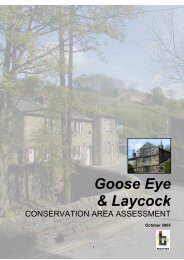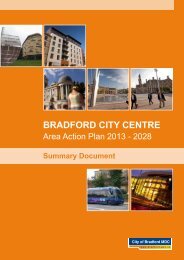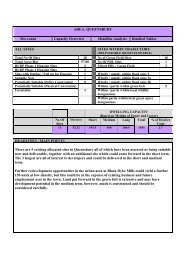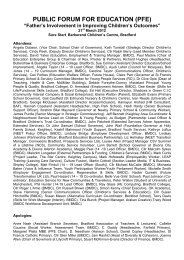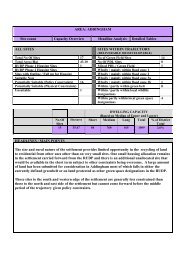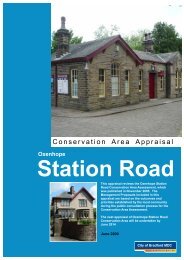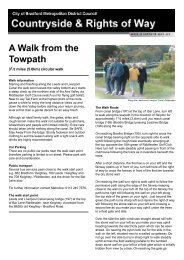Landscape Character Supplementary Planning Document ...
Landscape Character Supplementary Planning Document ...
Landscape Character Supplementary Planning Document ...
You also want an ePaper? Increase the reach of your titles
YUMPU automatically turns print PDFs into web optimized ePapers that Google loves.
City of Bradford Metropolitan District CouncilLocal Development Framework For BradfordSpinning and weaving was initially still carried out at home but as more complicatedfinishing techniques were required new buildings were built for the first time specificallyfor industrial purposes.Waterpower was used extensively, the fast running streams from the moors providingideal sources. Reservoirs still a major features of the upland landscape today began toappear in the hillsides to regulate water for the mills.As time when on larger buildings were needed to house the new machinery andworkforce. These would often be located in the valley bottoms where advantage couldbe taken of good communications and the larger watercourses both in the techniquesthemselves, and as a source of power and for transport.Stone quarries appeared, scarring the landscape as they fed the textile industry’sappetite for materials for buildings and walls to enclose the land needed for rearing moresheep. Stone, both grit stone for buildings and ‘York stone’ setts for flags and pavingcontinued to be the almost sole materials used in rural locations right through to the earlydecades of the twentieth century.Bustling lowland towns quickly developed with separate communities from the scatteredhamlets of the uplands and what had begun as a cottage subsidiary industry was well onits way to becoming mechanised industry of international proportions.Steam Power8.10 Following the invention of the steam engines in the early 19 th Century steam began totake over from water a power source. Coal mining and coal transport becameincreasingly essential as the mills consumed huge quantities of the black stuff. In anattempt to control pollution tall chimneys were built which are still a notable feature in thelandscape today.Bigger mills were needed to house new and more machinery and by the end of the 19 thCentury they were enormous imposing buildings, which became the focal points for largecommunities of urban workers living in the towns, which grew around them.In the mean time, as the demand for wool to supply the mills and produce to feed thetown workers increased, the agricultural community also flourished. The pressure forexpansion was great and with the Parliamentary Enclosure Acts of the 18 th Centurymuch land along the moorland fringes was enclosed. The total area of land used foragricultural peaked at the time. Miles of dry stone walls were used to demarcate fieldboundaries, which are an essential element in the rural landscape of the district today.<strong>Landscape</strong> <strong>Character</strong> <strong>Supplementary</strong> <strong>Planning</strong> <strong>Document</strong>October 2008 Page 35




